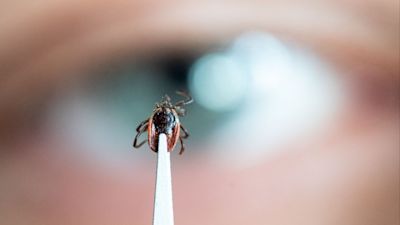Warning over 'invisible' illness Lyme disease that can cause 'debilitating' symptoms

Campaigners are urging people to be aware of an "invisible" illness which can have serious consequences.
Lyme disease, an infection which can cause "debilitating" symptoms, is spread to humans by the bite of an infected tick.
The charity Lime Disease UK says ticks can be prevalent in woodlands and countryside areas as well as urban parks and gardens.
"We don't want people to be scared of enjoying the outdoors", said Natasha Metcalf, co-founder and chair of Lyme Disease UK.
"But rather that people go out armed with the facts and knowledge they need to protect themselves and others from Lyme disease. Early intervention is key, and getting that message out to the public is crucial."
What is Lyme Disease?
Lyme disease is a bacterial infection that can be spread to humans by infected ticks - tiny arachnids that live in woodlands, long grass, and sometimes urban parks and gardens.
Lyme Disease UK says the illness can have a "huge impact" on the lives of those suffering with the condition. But it is preventable and treatable, especially if caught early and treated quickly.
What are the symptoms?
Symptoms can include a circular or oval shaped rash around a tick bite. This can occur up to three months after being bitten, but the NHS says it usually appears within 1-4 weeks. Lyme Disease UK says up to a third of people with the disease will not develop a rash.
Others may experience flu-like symptoms, including a high temperature, headache, muscle pain and tiredness.
If treatment is delayed, some people may go on to develop more serious symptoms including pain and swelling in joints, nerve problems such as pain or numbness, heart problems and issues with memory or concentration.
Lyme Disease UK says these symptoms can be "debilitating" and may mimic other conditions, including long-Covid.
What are the chances of catching Lyme disease?
Not all ticks carry Lyme disease. But the NHS says it's still important to be aware of ticks and to safely remove them as soon as possible, just in case.
Lyme Disease UK says there are around 3,000 new cases each year in England and Wales, but warns the real number could be up to three times higher.
Ticks that may cause Lyme disease are found all over the UK, but the highest risk places include grassy and wooded areas in southern and northern England and the Scottish Highlands.
How is it treated?
If you've been bitten by a tick or visited an area in the past 3 months where infected ticks could be and you have flu-like symptoms or a round or oval shape rash, the advice is to see your GP.
They will ask about your symptoms and if they think you do have the infection, you will be prescribed a course of antibiotics.
How can I avoid being bitten by a tick?
To reduce the chance of being bitten by a tick, the NHS advises covering your skin while walking outdoors and tucking trousers into socks.
Insect repellent applied to clothes and skin can also be of use - products containing DEET are said to be best.
Other advice includes staying on clear paths whenever possible and wearing light-coloured clothing so ticks are easier to see and brush off.